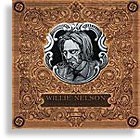
It’s ironic that one of the terms coined to describe the music various singer/songwriters were making in Austin in the early 1970s was “progressive country” (others being “redneck rock” and the more marketable “outlaw country”). Because the brand of country that Nashville defector Willie Nelson, hippie eclectic Doug Sahm, and New York folk-rock import Jerry Jeff Walker were making paid respect, and owed much, to country roots.
It’s no accident that Shotgun Willie, Nelson’s 1973 debut with Atlantic, marking his break from the Nashville establishment, included two Bob Wills staples and “Whiskey River,” a song written by honky-tonk singer Johnny Bush (who’d been Willie’s drummer a decade earlier). Along with two Leon Russell tunes, the remaining seven were penned by Nelson, including the cynical “Sad Songs And Waltzes” (“aren’t selling this year”).
Cut in New York, with Arif Mardin producing, the album has a loose, funky feel. Willie’s own band was augmented by like-minded players like Sahm, David Bromberg, Waylon Jennings, and Hugh McDonald (who later joined Bromberg’s band and has been Bon Jovi’s bassist for 20 years). Willie’s trademark nylon-string handles some of the solos, but the lion’s share is split between lead guitarist Steve Burgh and pedal steel great Jimmy Day. On the two songs featuring strings, the arrangements were done by Mardin and R&B star Donny Hathaway. In other words, it couldn’t have been less countrypolitan.
Nelson had moved back to Texas in early 1970, after his Nashville house had burned to the ground on Christmas Eve – an ironic symbol of the bridges he’d burned and was about to burn in Music City. As Bill Belmont states in the box set’s liner notes, “Whether he knew it at the time or not, Willie Nelson needed Austin as much as Austin needed Willie Nelson. It was a marriage made in hippie-hillbilly heaven, and the music Nelson would make in the first four years of the ’70s would not only change the city forever, but it would also start a sonic movement heard around the world. Some might say it also saved country music from itself.”
For Nelson’s follow-up, 1974’s Phases And Stages, producer Jerry Wexler brought Willie to Alabama’s Muscle Shoals Sound studio, utilizing the increasingly famous rhythm section of drummer Roger Hawkins, bassist David Hood, keyboardist Barry Beckett, and guitarists Pete Carr (lead) and Jimmy Johnson (rhythm), with the addition of pedal steeler John Hughey, fiddler Johnny Gimble, and Fred Carter, Jr., on guitars and Dobro.
It’s been said that it was one of the first country concept albums, but that’s an understatement. There had never been a country album like this. The songs tell the story of a failed marriage, first from the man’s perspective, then the woman’s, with the “Phases And Stages” interlude transitioning from one song to the next. Not the stuff country hits were made of, but Willie didn’t have any illusions about heavy rotation on country radio; he was making music for a different audience, and for himself.
Willie’s jump to Columbia with 1975’s Red Headed Stranger and 1976’s Wanted!, The Outlaws collaboration with Waylon Jennings, Jessi Coulter, and Tompall Glaser, broke down any commercial barriers and made him a household name. But his Atlantic period set the stage and remains his artistic high-water mark.
The box set presents both albums with several alternate takes and songs not included from the same sessions. A third disc, Live At The Texas Opry House, consists of an Austin concert from 1974 that was not released for almost 20 years – again, with additional tracks not on the ’93 album, now out of print.
Of all the Willie Nelson retrospectives, this may not be packed with the most hits, but it’s the most significant in terms of his evolution as an artist.
This article originally appeared in VG‘s Sep. ’06 issue. All copyrights are by the author and Vintage Guitar magazine. Unauthorized replication or use is strictly prohibited.


